Morbic 12
12345
12345
|
|
Question Grum
Which way round do you reckon to lie - head forward, or head aft? I wasn't going to mention this, but seeing as you've been kind enough to flatter me by recognizing the divided thwart, I will add that like you I was going to hinge it.... However, Polly Wee is sufficiently narrow and be-sidedecked that, unlike the Morbic, there would not have been room to open it. And to show that we all make mistakes, I am of a mind to (?remove the net hammock and) sleep on the floorboards for two reasons - 1. With the small buoyancy tanks built in under the side decks at thwart level, there is not a lot of room for chests, shoulders and elbows and such - somewhat claustrophobic. I had considered removing these, but I feel they probably provide enough buoyancy to discourage any tendency to turn turtle if capsized. Despite her midships cross-section, the sole provides a noticeable amount of extra space -  
2. Though I tend to keep her 'in ballast' at night anyway, the boat is a lot more stable with my weight on the sole rather than at thwart level. The only disadvantage would occur if, as happened one night, the water ballast system sprung a leak. I managed to stay dry on the net, but would have been decidedly moist if I'd been on the sole. Thank goodness I had closed the seacock - lesson learned. 3. I actually use the removable half thwart as a back rest when sitting on the sole, facing aft, tucked up toward the cuddy, at anchor, sipping my morning coffee, or evening beer and watching the world go past and such, while the breeze blows over my head.... One of the best bits of any trip CW |
|
|
Nice ideas re. the hinged bar top and forward storage/buoyancy/seat.
|
|
|
Thanks for all your kind remarks.
It's always a bit nerve wracking baring your soul around here. So many opinions, so freely given :) So to tick them off one at a time and in no particular order; Floorboards. Its interesting that M. Vivier doesn't include floorboards in the plans. The hull bottom plank is flat in cross section and fairly substantial at 9mm sheathed with glass and epoxy inside and out. Internally there is no keelson, there are no floors or ribs apart from the midships frame beneath the main thwart. Externally the stem and skeg stop short of the CB case. There aren't even any rubbing strips shown. Well Francois obviously doesn't sail in Chichester Harbour with its wide selection of flint and gravel on the hards, so my boat has two rubbing strips on each side positioned to keep the CB slot off the grinding bottom. Cliff may not think floorboards are necessary but then he sails a Mirror, which doesn't have any. I would guess he has floorboards on his Wayfarer. Floorboards have the advantage of keeping nearly everything out of the bilge water and in spreading the load of the crew's feet over a number of floors rather than having all the weight on a single point, which is maybe the reason so many old Mirrors end up with boot shaped holes in the bottom. There can only be two reasons for fitting a sealed sole in place of floorboards. To provide a tank for water ballast. e.g. Swallow Boats Bay Raider. Or To provide space for internal buoyancy. I wouldn't do it just to create a strum box for a pump. That's just lifting the puddle a few inches higher. It is quite possible to have too much buoyancy in a dinghy. I read recently that too much buoyancy low down can make a swamped boat very unstable, making it impossible to get back in after a capsize as the boat simply rolls over on top of you. Similarly too much buoyancy in the sides can mean that a fully upturned boat is very difficult to right because you can't get one side to sink far enough. I've seen photographs of a capsize drill on a Morbic 12 and she floats nicely on her side without taking on too much water. The boat is designed by a qualified Naval Architect using state of the art software including buoyancy and righting moment calculations so I'm not about to change anything which might affect the results. I deliberately decided that the Locker/Thwart would not add to the internal buoyancy of the boat so it has limber holes which will allow it to flood in the event of a capsize. I'm not averse to fitting a pump sometime in the future, but I'll wait and see how wet the boat is in use and where the strum box needs to be. 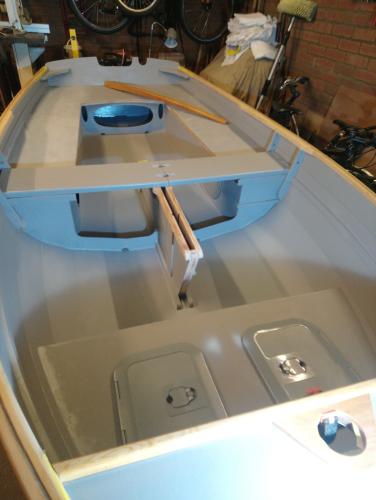 It is my intention to sleep with my head forward. The height of the platform is approx. half-way between the floor and the side benches and at the same level as the Thwart/Locker, hopefully a good compromise between dampness and stability. The narrowest point is between the aft end of the CB case and the side tank, this widens at the forward end of the tank and then opens right out at the forward end of CB case which potentially gives increasing amounts of room for bums shoulders arms etc. As mentioned previously the actual construction of the sleeping platform is still under consideration but I've added cleats to the CB case and side tanks to support it. Of course the risk is that my weight will upset the trim to the extent that I end up with my head lower than my feet and heeled over at a dangerous angle, in which case The Ball is On The Slates. She's a beamy little flatish bottomed boat so hopefully it'll be OK, we shall have to wait and see. So; Sealed Sole, NO. Bilge Pump, Maybe. Floorboards, Perhaps. Head Forward, Hopefully. Now was that everything? Don't let the second wave knock you off your feet. Graham. |
|
|
Richard has just posted pictures of the mast travellers he made out of some bronze bar "as you do!"
Or in my case "as you don't". I've checked and you have saved yourself around £90 plus post and packaging so well done. Deep inside the box of bits I rescued from the Ancient & Vulnerable Skip was this; 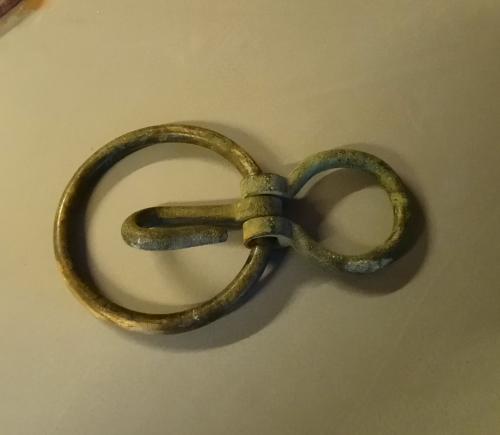 Now I'm not exactly sure what it was originally intended for. Its made of bronze and it might be a mast traveller, or maybe a bowsprit traveller. Anyhow the hook and ring move independently of one another and the smallest internal dimension of the big ring is 70mm which sadly isn't quite big enough for my mast. If anyone knows what it is, do let me know. Graham |
|
|
Very nice Graham. It is a traveller of some sort. Give me a ring sometime.
Richard |
|
|
Give me a ring. Every one a winner. 😁 Sent from my Xperia by Sony smartphone ---- inwe [via UK HBBR Forum] wrote ---- Very nice Graham. It is a traveller of some sort. Give me a ring sometime. Richard If you reply to this email, your message will be added to the discussion below:
http://uk-hbbr-forum.967333.n3.nabble.com/Morbic-12-tp4030796p4031627.html
To start a new topic under Builds in Progress, email [hidden email]
To unsubscribe from UK HBBR Forum, click here. NAML |
|
|
This post was updated on .
I think it has to be a traveller for a bowsprit Grum
Richard has made what I understand to be the classic design for a mast, where the hook is fixed because the yard always needs to be held and stay close to the mast while being hauled up to whatever height your luff may allow, even when reefed. When hauling the tack of a flying jib out along a bowsprit, it starts off trailing horizontally, or worse, trying to fall under the bow. Once 'out there', the angle is that of the luff whose tension heads to somewhere up the mast and that direction changes again as you sheet in and the sail starts to draw so that some of the strain comes on the foot. So it needs to work in a range of different directions, hence the freely-moving-hook-on-an-eye-on-a-traveller Make sense? CW |
|
|
Thanks for the explanation Chris.
Sounds like the sort of thing someone would hand you and say, "Here build a boat round that". If anyone is planning to build a boat with a jaunty bowsprit and needs a traveller then please get in touch. G. |
|
|
Things have been a bit up in the air over the last few days.
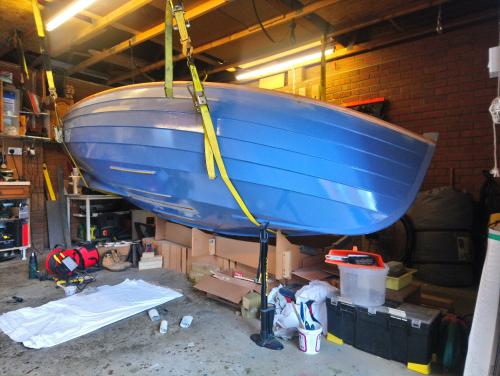 Been tidying up the CB slot. I need someone with brains less addled than mine to check my logic and maths. The plans for the Morbic show a central mainsheet arrangement with a 4-1 purchase. Now that would be fine, I quite like a central mainsheet but it is likely to cause me some grief. I have been educated by wiser men that lazy jacks are a very useful addition to any rig but especially a balanced lug. Imagine the scene, you come sailing majestically onto the hard at Cobnor, to prevent a crash landing you decide to shorten sail and gradually lower the sail into the boat. Only on a balanced lug the first thing to happen will be the yard capsizing and if that doesn't knock you out cold it is likely to come crashing down round your ears then go over the side taking the whole sail and probably the boom with it. If you listen carefully you might hear a round of sarcastic applause from the bench full of DCA Jolly Jack Tars who have been sitting watching the whole operation. With Lazy Jacks the yard is controlled in its descent and will fall smoothly into the arms of the boom bringing its sail neatly with it, you can then sit down quietly to row your boat ashore with a minimum of fuss and total lack of sarcasm. So Lazy Jacks are a must. But. There's always one. With the boom, yard and sail neatly bundled above you head swinging on the lazy jacks the pesky centre mainsheet is going to be swinging right in front of your eyes and down between your knees just where you want to swing your oars. So, fit the main to the end of the boom I hear you all cry. This is where the maths comes in. If the boom is 3m long the length of the centre main needs to be; The hypotenuse of the triangle created by the middle of the boom fully sheeted in and the boom fully out times 4, for a four part system, plus a couple of meters to hold in your hand. I've done the Pythagoras and the hypotenuse is 2.1m so; 4x 2.1 + 2= 10.4m Now if the mainsheet is at the aft end of the boom a four part system would need; 4x 4.3 +2 = 19.2m But With the sheet at the end of the boom there is a far greater mechanical advantage as the load is twice as far from the fulcrum (mast) than the centre main so it only needs to be a two part system. 2x 4.3 +2 = 10.6 m In other words pretty much the same length. Here's a photo to help your deliberations. 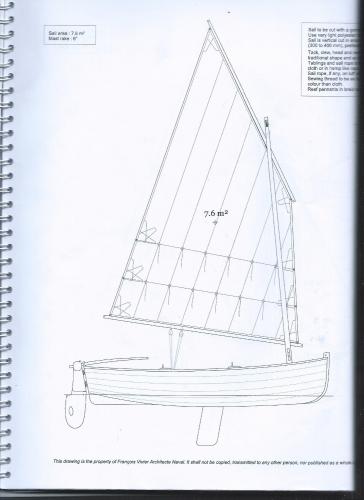 And another, this is the arrangement on my Coot where the sheet is led along the boom and then the bitter end falls to hand. By my calculations this is a three part system and at least with this system the free end can be tied off out of the way but I do recall it always managed to catch the oar or knock your hat off when you really didn't want it to. 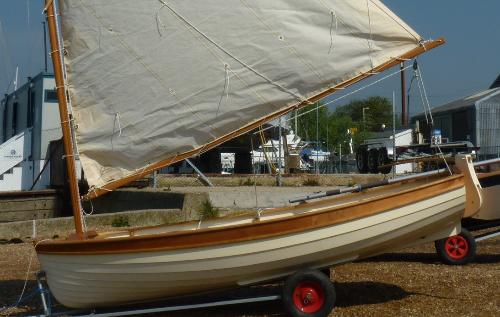 So the question is, what do you think the best solution is? I have many more questions of this type so please pay attention, there will be a test at the end. Thanks in advance. Grum. |
|
|
MilliBee has a 3:1 block at the end of the boom, to which I fitted a 10m length of rope (give or take).
With 4:1 there will be a huge amount of rope to trip over when sheeted in. -Paul |
|
|
A flying boat - interesting. I shall be monitoring this thread as I now face the same dilemmas but with the added oar system.
Richard |
|
|
In reply to this post by Paul H (admin)
How big is your sail area? I use 3:1 centre sheeting the Solo (80sqft), and would go up to 4:1 only when it was blowing so hard any sensible person would have been reefing instead of racing. On the Wayfarers we use 3:1 both on transom and on centre sheeting.
Maybe one answer is to put a hook on the upper mainsheet blocks, and unhook them from the boom when you want to row. (Assume your lazy jacks are so rigged so you can lift the whole rig clear of your head - needs a lift by the tack as well as towards the clew) Simon |
|
|
In reply to this post by Port-Na-Storm
Lovely; I can only take you through Polly Wee's systems
Slightly shorter hull (11' 6"), same sail area (80 square feet) and the same balance lug. I have what amounts to a turning block at the aft end of the boom with the equivalent of a becket on it, (it's actually a smaller sheave, but it's all I had). A rope horse used to traverse the stern deck some four inches forward of the transom with a single sheave block sliding on it. I've now moved it to the aft end of the cockpit for two reasons; discourages it from getting caught under the quarter when gybing and is easier to reach when forcing a gybe anyway. I have a sneaking feeling she does not point quite so well like this, (eons of experience - Oh yes, Christopher?), but she sure is easier to handle when wearing ship, so I've not moved it back - 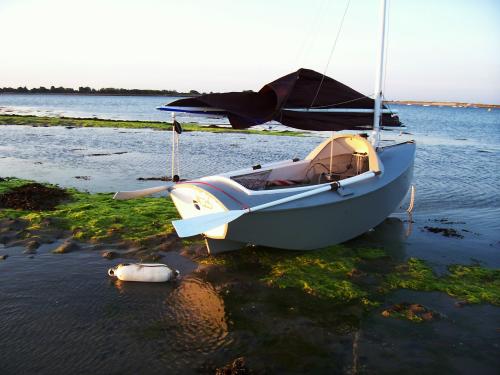 Horse is the red line which I also use to trap the oars when not in use. Leading it forward like a Laser, I have a small eye hung under the boom over the after part of the cockpit. Passed through this, I find myself less likely to be garroted, or otherwise inconvenienced by the sheet when tacking. Watch out if you're wearing a lifejacket with a roll round the back of the neck, the roll and the rope are desperate for each other - - 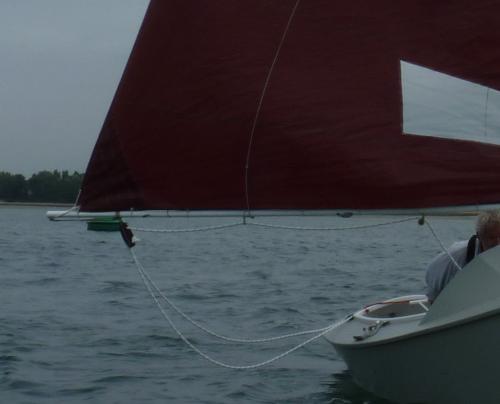 Note the single sheave block further forward under the boom. This turns the sheet, so that you can bring it down to working level. Grum, you may wish to terminate here with your new-found ratchet jammer in terrific Tufnol. I have gone down to a point be-(same as the sail)-side the centre board case and because the gunwale is so much higher than the top of the case itself and there ain't much room for other actvities, I've mounted my favourite swivelling jammer on a removable stump - 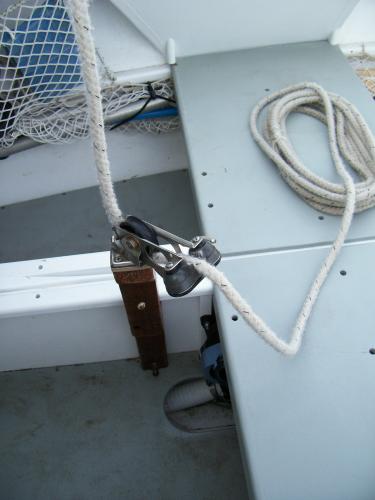 If you end up with a jammer, as I was warned when I first tried one on a Solo - do not leave it jammed when you go about as you are likely to capsize. At least give it a handful of slack. I find this level of purchase absolutely fine for handling under pretty much all conditions and you almost certainly will as well. Next the topping lift. If you set it up as a double lift with a fall coming down the outside (from the mast) of the sail, then it entirely traps the sail itself as you release the halyard; so.... So, using four mm line, I make an end off on the aft side of the truck and bring it down to an aft facing hook under the boom, pretty much where the majority of the bunt falls. Look at the second image above, you can see it just forward of the underhung-eye; the 'forward' bit is important as it means you can unhook it and let it run forward without fouling the mainsheet at that point. I then take it back, outside the sail, up to the truck where I have another small eye. Run it through this, down the outside of the sail toward the 'partners'.... Now it gets a tad technical, as I like to be able to raise the whole furled bundle above my head for rowing. In fact Grum if you want to do the same thing, I strongly suggest we have two-metre-bubble meeting by the boat down at Cobnor because trying to explain it, even with photographs, is going to prove, er, 'interesting' beyond the bounds of extreme confusion. There are at least half a dozen little quirks, some of which qwork better than others. How do you feel about that before I sit down to write something of the order of the entire works of Shakespeare? Christo the Convoluted |
|
|
In reply to this post by Port-Na-Storm
Graham,
Looking again at the Morbic plan I would put the block at the end of the boom, which is out of the way. Anything that clutters up the centre of the cockpit becomes a pain when tacking. But, experiment, as there will be some "kicker" effect sheeted at the middle which may improve sail handling. -Paul |
|
|
Here comes the Devil's advocate again -
The balance lug does not need a kicker, Paulie. With its yard and boom it can be considered to resemble an 'irregular' parchment scroll (that is a quadrilateral sail, pinned to its spars all the way along its top and bottom edges). The the yard at the top equates (according to my understanding of Wikipedia explanation of a scroll) to the 'stave' and the bottom where the boom equates to the 'roller'. Whatever, the orator can grab top and bottom bars and hold the scroll up to expound from; or on such a lug, the sail can be stretched. Thus restrained flat, the scroll remains legible and the sail remains functional and flat, bar any built-in camber (also unable to flog), regardless of any (reasonable) wind-strength. Again; the sheet already works from the aft end of the boom and comes forward past the usual helmsman's working area of cockpit, leaving it clear. This means that whatever device may, or may not be installed to control it, is ahead of your forward hand while the tiller (extension) is by your aft hand. It has the effect of not needing to sail with one arm across your body in order to hold both controls at the back of the boat. With a jammer on the sheet, this can be very convenient at least and much less tiring in the long run. If you have reason to need the space - for three small granddaughters for instance, then it is simple to remove the stopper knot pull the sheet back and handle it straight from the aft end of the boom. Christo the Infuriating |
|
|
I find this arrangement works well. Simple, out of the way and easy. There are cleats for the mainsheet on the stringers, but when I bought the boat the owner said "this is for cleating the mainsheet. Don't cleat the mainsheet.. So I never have.
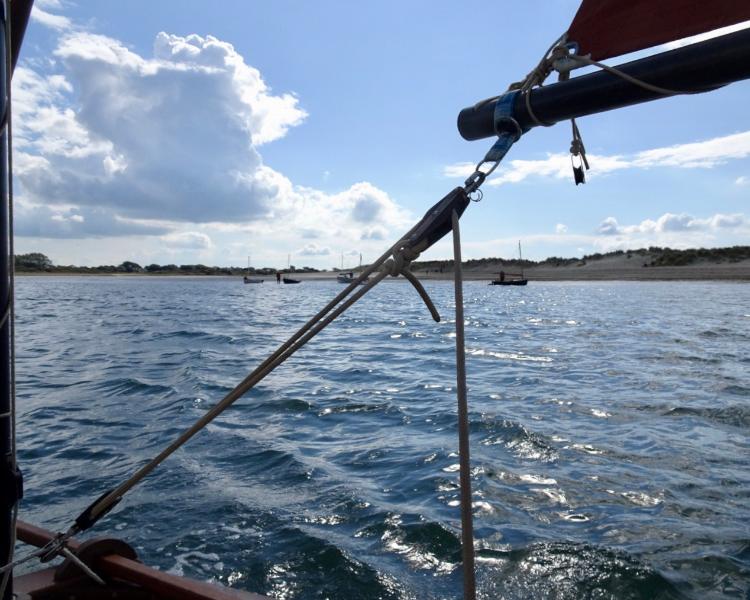
|
|
|
Horses for courses. MilliBee is quite stable when she heels; I find myself cleating the mainsheet often.
There is always enough time to luff a little or ease the sheet. Having seen the mighty Morbic hull, I predict she will have similar stability. Paul |
|
|
In reply to this post by Chris Partridge
Yes, Chris
That is the one I suggest Graham reverts to when sailing with passengers aboard. Do you not find that forever having to hold the mainsheet gets tedious and occasionally hard on the hands? Paulie, the Morbic is a light open dinghy, Millibee is an under-canvassed pocket cruiser. Having said that I have a jammer on Polly Wee, but with a lead from a position forward. This means I have instant access to it when sailing upwind, not having to turn and face aft to have it in view while in use. It makes it much, much quicker to adjust. CW |
|
|
Yes, holding the rope is boring and hard on the hands but I am driven by fear...
|
|
|
Maybe a softer rope?
|
«
Return to Builds in Progress
|
1 view|%1 views
| Free forum by Nabble | Edit this page |

